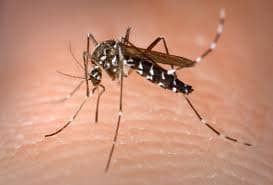The Ms. Shawn Burgess, Department of Agriculture, Mosquito Control Section, 8071 Greenmead Drive, College Park, MD 20710 Office: (301) 422-5080 Fax: (301) 422-0502 has been advised of the many complaints from residents regarding mosquitoes abatement this spring.
Ms. Burgess provided a MDA brochures.pdf how to monitor and control mosquitoes at home.
MDA will provide evening pesticide applications via truck spraying starting May 27, 2015.
Please contact Ms. Burgess at (301) 422-5080 for further information or Baltimore County Department of Environmental Protection and Sustainability and Environmental Health Eastern phone: 410-887-4066.
For additional help contact Fort Howard Community Association at 410-477-2040.
AND REMEMBER: mosquitoes can fly at about 1 to 1.5 miles per hour. Mosquito species preferring to breed around the house, like the Asian Tiger Mosquito, have limited flight ranges of about 300 feet. Most species have flight ranges of 1-3 miles.
TAMING THE ‘TIGER’
The Asian tiger mosquito has become a serious pest in parts of your county. It doesn’t respond well to traditional mosquito control methods. Here are a few ways you can help tame the “tiger”.
• Check your yard for any container that can hold water. The “tiger” lays its eggs in these sites and they hatch within a few days of being flooded. Even small containers such as drinking cups can produce mosquitoes. Remember to check gutters, too. If you find any water-holding containers, dispose of them or change water weekly. Keep gutters free of leaves and debris.
• Talk to your neighbors about the “tiger”. Since the adults can fly 100 yards or so, your problem may be coming from containers in someone else’s yard! Most people don’t know what mosquito larvae look like or that they can breed in very small amounts of water. One tire with a few cups of water can breed hundreds of mosquitoes continuously throughout the warm months.
• Make sure screens are intact. Good screening on doors and windows will keep “tiger” outside.
• Spray sheltered areas in your yard with an insecticide labelled for adult mosquitoes if you cannot tolerate the annoyance caused by mosquito bites. “Tiger” adults rest in dark sheltered areas around your home such as under decks or porches, in thick or low-growing vegetation, or in outbuildings or sheds with gaps they can enter. Spraying these areas will keep the numbers of adults down in your yard. Read and follow all directions on the insecticide label.
• Talk to the officials in your neighborhood. If you live in an incorporated area or have a local association, talk to the board members or council members about the “tiger”. An organized clean-up and education program can keep “tiger” populations to a minimum in most areas.
Also, try using an electric fan when sitting outside. “Tigers” are relatively weak fliers and may not be able to reach you to bite if a fan is blowing.
The Asian tiger mosquito is an annoying pest in many areas but YOU are your own best defense! For more information on the “tiger”, call your local mosquito control office.
SPRAYING FOR ASIAN TIGER MOSQUITOES*
A. Find and eliminate all breeding sites – spray treatment will do no good if the source of the problem is still present. Look for containers holding water such as:
tires – potted plant saucers – plastic covers & tarps neglected toys – wading pools – clogged rain gutters – bird baths
B. Choosing a Pesticide
1. Once you have determined that you have Asian Tiger mosquitoes and you want to spray, you need to purchase the correct pesticide from a hardware store or a professional pest control agency.
1) READ THE LABEL – Make sure that what you choose is labeled for treatment of mosquitoes.
2. There are many different brand names that will work, but some of the active ingredients that you will find listed on the label which work well against Asian Tigers are:
Resmethrin
Permethrin
Pyrethrin
These are just suggestions – there are others that also work.
C. Applying the Pesticide
1. READ THE LABEL THOROUGHLY AND FOLLOW DIRECTIONS EXACTLY.
2. Adult Asian Tigers spend most of the time resting in bushes, ivy, tall grass, under decks, and in other shady, sheltered areas. Concentrate treatment in these areas.
3. Although they are active all day, Asian Tigers seem to be most active around dusk. Therefore, this is the best time to treat.
Kathleen Labuda
Secretary/Treasurer
FHCA
“It’s our community, let’s take care of it.”



